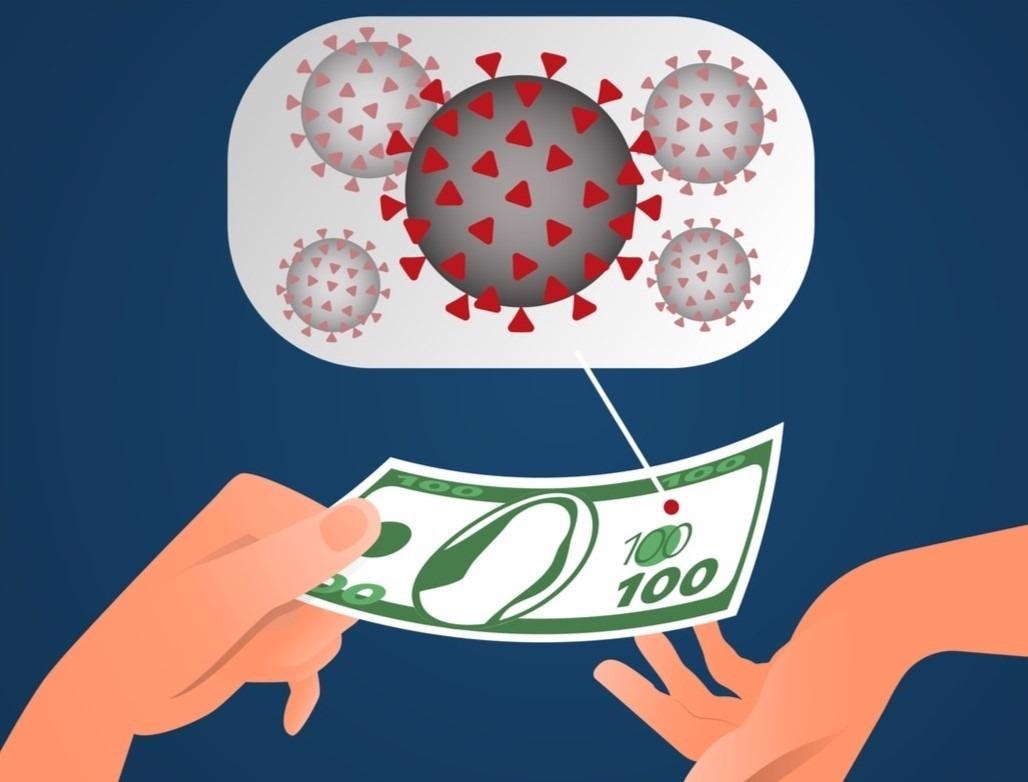The current coronavirus disease 2019 (COVID-19) pandemic caused by the severe acute respiratory syndrome coronavirus 2 (SARS-CoV-2) has sparked global concerns due to widespread beliefs about virus transmission through currency exchange. These concerns arose in response to the growing fears that regularly handled objects such as banknotes and coins could operate as a vehicle for the transmission of a variety of dangerous pathogens, including SARS-CoV-2.

Study: Risk assessment of banknotes as a fomite of SARS-CoV-2 in cash payment transactions. Image Credit: legdrubma / Shutterstock.com
The United States Centers for Disease Control and Prevention (CDC) has recently released a science brief on the possibility of SARS-CoV-2 transmission through surfaces. According to these reports, the risk of fomite-mediated transmission is dependent on the infection prevalence rate in the community, amount of virus expelled by infected individuals, deposition of expelled virus particles onto surfaces (fomites), the interaction of expelled virus particles with environmental factors, the time interval between surface contamination and a person touching the surface, and the efficiency with which virus particles transfer from fomite surfaces to hands and from hands to mucous membranes.
The risk of SARS-CoV-2 infection from fomite exposure is regarded lower in comparison to the risk of transmission through direct contact, droplet transmission, or airborne transmission. To better understand this, a new study published on the medRxiv* preprint server evaluates the risk of SARS-CoV-2 exposure by fomite transmission during cash transactions.
About the study
The current study used a quantitative microbial risk assessment (QMRA) to assess the risks associated with a worst-case scenario, in which an infectious person contaminated a banknote by coughing on it and then immediately handed it over to a recipient.
A plume of respiratory droplets containing SARS-CoV-2 virions is produced by coughing. By touching the freshly contaminated banknote, virions are transferred from the banknote to the acceptor's fingertips. The quantity of virions transported from the acceptor's fingers to their eyes, nose, or mouth is therefore considered to be the viral dose.
The scenario addressed the transmission effectiveness of virions on the banknote to fingertips while the droplets were still wet and after they had dried and were then touched by fingerprinting or rubbing the object.
Study findings
It was shown that the number of virus ribonucleic acid (RNA) copies contained in a single cough caught on a banknote region of a size covered by fingertips varied by many orders of magnitude due to the substantial difference in virus concentration in patient material and in the volume of coughed droplets. The numbers trapped on a banknote in a fingertip-sized area were approximately 400 times lower than the numbers found in a single cough.
Under damp conditions, the numbers transmitted to the fingertips were reduced by nearly five times. Printing and rubbing lowered the virus RNA copy counts by 20 and 400 times, respectively, under dry conditions.
The dose, or amount transferred from the fingertip to the facial area, was approximately one-third of the number on the fingertips. In the end, the dose was around 5,000, 25,000, and 500,000 times lower than the number of aspirated virions in the wet, dry/print, and dry/rub scenarios, respectively.
It was also shown that under wet conditions, transfer efficiency for printing and rubbing were identical; however, under dry conditions, transfer efficiencies for rubbing were lower than for printing. According to the statistical analysis of the transfer efficiency data, input concentration and surface type did not significantly affect transfer efficiency, whereas dry/wet conditions and printing/rubbing did.
Transfer efficiencies were on average 10 times higher under wet conditions than under dry conditions. Comparatively, transfer efficiencies were on average three times lower for rubbing compared to printing.
In terms of the transfer of banknotes by wet, dry/print and dry/rub circumstances, the associated mean risks were 0.17, 0.082, and 0.014, respectively. Due to the vast variations of viral particle transfer numbers, the risk distributions ranged from zero to one. These risk estimations can be translated into contracting COVID-19 once per 6, 12, and 71 cash transactions for the wet, dry/print, and dry/rub transfer conditions, respectively.
In essence, under the worst-case scenario, the risk can be considered high in the wet transfer scenario, with an approximately average virus concentration of 108 virus RNA copies/ml.
Conclusions
The total risk of transmission through banknotes between members of the general public without protection is extremely low, at less than once every 39,000 days. The worst-case scenario examined in this research is a high-risk event, which is a rare occurrence.
Cashiers are obviously more at risk than the general public, yet they still have a low probability of contracting COVID-19 through fomite exposure when handling cash. More research is needed to determine whether the danger increases greatly as a result of potentially newer SARS-CoV-2 variants.
*Important notice
medRxiv publishes preliminary scientific reports that are not peer-reviewed and, therefore, should not be regarded as conclusive, guide clinical practice/health-related behavior, or treated as established information.
- Schijven, J., Wind, M., Todt, D., et al. (2021). Risk assessment of banknotes as a fomite of SARS-CoV-2 in cash payment transactions. medRxiv. doi:10.1101/2021.12.03.21267258. https://www.medrxiv.org/content/10.1101/2021.12.03.21267258v1.full.pdf.
Posted in: Medical Science News | Medical Research News | Disease/Infection News
Tags: Contamination, Coronavirus, Coronavirus Disease COVID-19, Cough, Coughing, Pandemic, Research, Respiratory, Ribonucleic Acid, RNA, SARS, SARS-CoV-2, Severe Acute Respiratory, Severe Acute Respiratory Syndrome, Syndrome, Virus

Written by
Nidhi Saha
I am a medical content writer and editor. My interests lie in public health awareness and medical communication. I have worked as a clinical dentist and as a consultant research writer in an Indian medical publishing house. It is my constant endeavor is to update knowledge on newer treatment modalities relating to various medical fields. I have also aided in proofreading and publication of manuscripts in accredited medical journals. I like to sketch, read and listen to music in my leisure time.
Source: Read Full Article
